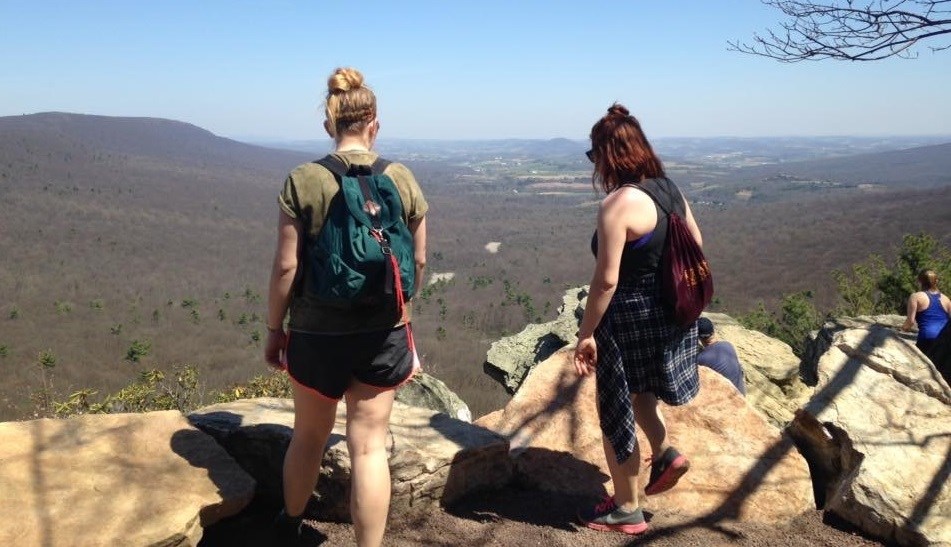
Hiking Tips at the Mountain
A walk in the woods can refresh the spirit and reconnect you with nature. Be sure to follow the tips outlined on this page if you are traveling to North Lookout, or any trail beyond 3/4 mile.
Click here to see updated info on visiting the Sanctuary during the COVID-19 Pandemic, including a list of strongly recommended hiking etiquette.
Before you leave home, study the Trail Map, and know your route. Leave a copy of your itinerary and the location of your vehicle with someone you trust. At Hawk Mountain, review all trail descriptions once more, ask any questions, and carry the trail map with you.
A walk to the North Lookout is suggested for the first-time visitor and any other inexperienced hikers. This walk will take at least an hour, usually longer, if you stop at overlooks along the way.
Don't try too much! Families and youth groups should keep it simple and you'll have a nice day at Hawk Mountain. In advance, review with children the trail map and safety tips, and together pack up your "essential gear." This is a great outdoor lesson that gets the kids excited, no matter the length of your walk.
Scout and other youth group leaders are STRONGLY ENCOURAGED to complete a practice hike before bringing a group of children. This gives you the best and first-hand knowledge of the trail conditions, and the time you need.
Visitors who carry a pack-in, pack-out lunch and eat at North Lookout tend to have a full and enjoyable afternoon. If visiting in autumn, bring binoculars or plan to rent them at the Visitor Center.
At Hawk Mountain, and in any outdoor area, always remain on the trail for your own safety and to help protect the fragile ecology of the forest. Obtain and study a trail map before you depart.
Slips and falls can be minimized by wearing boots or sturdy shoes with good tread. All trails, aside from the graded walk to South Lookout, are rocky, mountainous terrain that provides uneven footing. Be sure to take your time, and watch where you step. Take extra care after rain, especially during late October and November when leaves can make the trail slick.
Hawk Mountain is typically 10 degrees cooler on top of the Mountain than in other areas, so check the forecast with this in mind.
You'll want to wear a hat and sunscreen on sunny days, no matter the season and dress in light, warm layers during autumn and winter. If you become warm, you can shed a layer and stash it in your daypack. A protective "shell" will help shield you from snow, rain and wind.
A convenient, lightweight daypack will carry your snacks, water, binoculars, camera while leaving your arms free. You'll be glad you brought one.
Always overestimate the amount of time it may take you to complete your walk so you are finished well before dusk. Double the amount of time when hiking with children.
Keep a stocked daypack for hikes beyond a half mile, and always carry more water than you think you may need. The uneven terrain, steep grades and hot weather all can leave you exhausted or dehydrated. In all outdoor circumstances, you cannot rely on finding water, and should never consume untreated water in the wild.
In your daypack, keep a working flashlight, extra batteries and bulb, and small first aid kit with any special medications you require. Don't forget to stock snacks and water!
We share the natural world with resident critters as well as fellow hikers, so keep noise levels to a minimum, and turn off cell phones. Be particularly aware of your noise level if traveling with a group so as not to disturb others or ruin an opportunity to spot wildlife.
Keep a stocked daypack for hikes beyond a half mile, and always carry more water than you think you may need. The uneven terrain, steep grades and hot weather all can leave you exhausted or dehydrated. In all outdoor circumstances, you cannot rely on finding water, and should never consume untreated water in the wild.
Bringing a cell phone is smart, but only if you use it in the event of a true emergency. When you request help, you put first aid responders at risk and incur considerable cost of time and money on the part of rescue personnel.